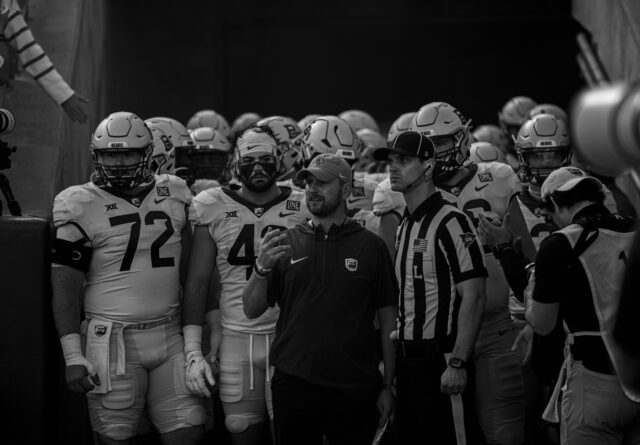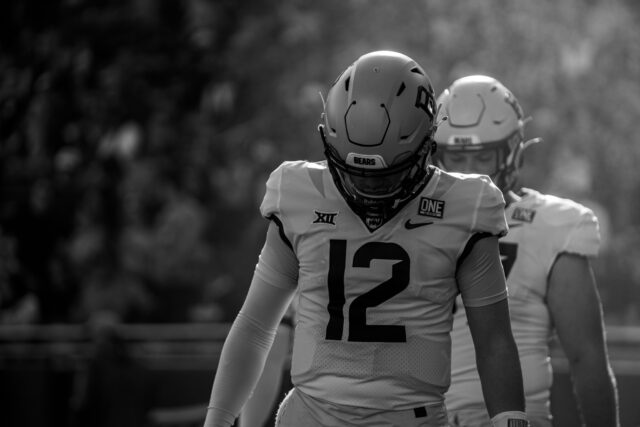By Jackson Posey | Sports Writer
From the Big 12 championship in 2021 to missing a bowl game in 2023, Baylor’s downfall has been swift and thorough — and it started with a loss to TCU in 2022.
Saturday was just salt in the wound.
The former Revivalry (now “Bluebonnet Battle”) became the most-played rivalry game in Texas, as Saturday marked the 119th iteration of a series that’s seen plenty of twists and turns since its advent in 1899. The latest twist — Baylor’s fall from its best season in program history (2021) to its present 3-8 predicament — has coincided with TCU’s own fall from its first national championship game appearance in 2022 to the need to win its final two games to secure bowl eligibility this year.
And in a game that never felt in doubt, the Horned Frogs stuck a fork in the Bears’ season, winning 42-17 in Fort Worth to keep its bowl hopes alive.
A year ago, Baylor entered this game with high hopes. The Bears were 6-4 — a disappointing start at the time — but each loss felt excusable. It’s hard to beat BYU in Provo, Utah; Oklahoma State was a top-10 team; then-redshirt sophomore quarterback Blake Shapen went down with an injury against West Virginia. Kansas State … well, better to not think about that one. But winning rivalry week would have presented a massive momentum shift for the Bears.
For a while, it looked like they’d do it in that 2022 matchup with TCU. With scant seconds melting off the clock, Baylor held a two-point lead. But a now-infamous walk-off field goal wiped that hope off Baylor fans’ faces — and the Bears haven’t been the same since.

The next week, they lost to Texas by double digits, then barely mustered 15 points against Air Force in the Armed Forces Bowl. With a clean slate the following season, head coach Dave Aranda’s squad lost at home to Texas State and then-No. 12 Utah, managed just 30 points against a hapless FCS team that gave up 40 points to Stonehill, was embarrassed by then-No. 3 Texas in front of a fan-led stadium blackout and needed a historic comeback to beat a transitioning Group of Five team in UCF.
That Floridian magic didn’t carry over, though, as Texas Tech walked into McLane Stadium as 2.5-point favorites and walked out with a 25-point win. Baylor got back in the win column against a Cincinnati team whose losing streak would reach seven games, but fell back to Earth against Iowa State, which was 42 days removed from losing to Ohio.
Houston, which came off a 41-0 drubbing at the hands of Kansas State, also left McLane Stadium with a win. And the suffering culminated in last week’s 59-25 loss to the Wildcats, who were a late replay review from handing the Bears their first 40-point loss since 2018.
To add insult to injury, the state’s longest-played rivalry was renamed after a flower that blooms in April. Expectations for the game were about as low as they can get: Baylor entered the game as 13-point underdogs to a conference rival with a 4-6 record. The game wasn’t televised on cable, the Bears’ fifth consecutive week to be streaming exclusive. And even those relatively low expectations managed to outkick their coverage.
Holding TCU to 100 yards rushing on 30 carries (3.3 yards per attempt) should feel like a win. But redshirt freshman quarterback Josh Hoover, who started his first game a month ago, got everything he wanted through the air. Hoover racked up 412 yards passing and three total touchdowns on 82.8% completion. His favorite target, senior tight end Jared Wiley, caught all seven targets for 178 yards and two touchdowns, including an 81-yard bomb in the second quarter that gave the Horned Frogs a lead they would never relinquish.
Scheme all you want, but football is about execution. And the Bears didn’t execute. Baylor’s offense went just 5 of 14 on third down to TCU’s 9 of 11. Aside from kneeling the clock out in the first half, the Horned Frogs made it inside Baylor’s 5-yard line on their first eight offensive drives; the Bears only reached TCU territory on half of their 10 drives.
The loss drops Baylor to 3-8 this season, and the mark is 2-8 against FBS opponents. The Bears haven’t beaten a non-transitioning power conference team since a 38-35 win over Oklahoma on Nov. 5, 2022, and they haven’t beaten one with a winning record since the week before that. They lost all five games against Texas schools with an average final score of 37-18.
Baylor is 0-5 against other Texas schools this year (Texas State, Texas, Texas Tech, Houston, TCU), including four double-digit losses.
The Bears lost those five games by an average final score of 37.2-18.4.#SicEm
— Jackson Posey ✞ (@ByJacksonPosey) November 19, 2023
It’s been a steep drop-off for a program that had looked poised to be at the forefront of the new Big 12. Multiple busted coverages and dropped passes characterized a generally ineffective game from the Bears, who lost the second half 28-7. 2022 Big 12 Offensive Freshman of the Year Richard Reese started the game but didn’t get a single carry. Aside from some early deep shots by Blake Shapen — several of which were dropped — nothing seemed to work offensively. The defense, as evidenced by the scoreboard, had plenty of struggles of its own.
The message from players and coaches after the game was the same old tune. Aranda opened his press conference saying he was “disappointed, frustrated, upset.” It’s a sentiment he’s expressed several times before, as after the Iowa State loss, Aranda said the feeling in the locker room was “disappointed, frustrated, angry.”
It was also brought up how frustrating it is to not translate what works in practice to the games.
“I’m not trying to take any credit away from TCU and the hard work they put in, but at the end of the day, I think any play that they had — a big play or a momentum swing — it was something that we didn’t do that we had practiced,” fifth-year senior offensive lineman Clark Barrington said after the game. “We just have to get better at the execution part. It’s things we saw in practice, things we did in practice. We just have to bring it over to Saturdays.”
The Bears will lace it up one last time next week, likely as sizable underdogs, against a resurgent West Virginia team that’s going bowling. The Mountaineers’ success could be instructive for Baylor. Many saw head coach Neal Brown as a lame duck entering the season, but he made radical adjustments to open this season, winning four of five to open the year after finishing 5-7 a year ago.

The easiest change to quantify is offensive balance: The Mountaineers dropped from 35.4 passing attempts per game last season to 26.4. That return to a more ground-oriented scheme has given the defense enough breathing room to allow 5.1 fewer points per game without any associated offensive drop-off. And still, at 7-4, some are questioning Brown’s job security.
Perhaps Aranda has a Brown-esque course correction ahead of him, perhaps not. But it may take an even more aggressive shift in philosophy to get this team back on track. Freshman cornerback Caden Jenkins affirming his commitment before the game is a good start, but with Shapen’s injury status unclear, there’s little reason to believe this team will look any better against West Virginia than it has the past month.
Baylor should be among the best teams in the Big 12. It has made New Year’s Six bowls under three different coaches in the past decade; that should be the recipe for lasting success. But that success hasn’t been sustainable — and the current iteration of this team isn’t any different. The constant return to the same issues, with little week-to-week improvement, is beginning to feel like the definition of insanity.



